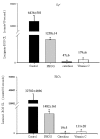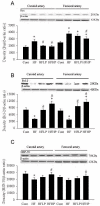Partially hydrolyzed guar gum supplement reduces high-fat diet increased blood lipids and oxidative stress and ameliorates FeCl3-induced acute arterial injury in hamsters
- PMID: 19272178
- PMCID: PMC2653517
- DOI: 10.1186/1423-0127-16-15
Partially hydrolyzed guar gum supplement reduces high-fat diet increased blood lipids and oxidative stress and ameliorates FeCl3-induced acute arterial injury in hamsters
Abstract
Increased reactive oxygen species (ROS) and hyperlipidemia can promote arterial thrombus. We evaluated the potential of a partially hydrolyzed guar gum (PHGG) as dietary fiber on lipid profiles and FeCl3-induced arterial thrombosis in the high fat-diet fed hamsters. Our in vitro results found that PHGG is efficient to scavenge O2-*, H2O2, and HOCl. High fat-diet increased plasma triglyceride, total cholesterol, LDL, VLDL, methylguanidine and dityrosine level and accelerated FeCl3-induced arterial thrombosis formation (from 463 +/- 51 to 303 +/- 45 sec). Low dose PHGG supplement significantly decreased the total cholesterol, LDL, methylguanidine and dityrosine level and delayed the time for arterial thrombosis formation (528 +/- 75 sec). High dose PHGG supplement decreased the level in triglyceride, total cholesterol, LDL and VLDL and further delayed the time for arterial thrombus (671 +/- 36 sec). The increased Bax protein and decreased Bcl-2 and HSP-70 protein expression was found in the carotid and femoral arteries of high fat-diet hamsters. Low and high dose of PHGG supplement decreased Bax expression and increased Bcl-2 and HSP-70 protein expression. We found that FeCl3 significantly enhanced intercellular adhesion molecule-1 and 4-hydroxynonenal expression in the endothelial site of damaged artery after 150-sec FeCl3 stimulation. PHGG supplement decreased the endothelial ICAM-1 and 4-hydroxynonenal expression after 150-sec FeCl3 stimulation. Based on these results, we conclude that PHGG supplement can increase antioxidant protein expression and thus decrease oxidative stress induced arterial injury.
Figures





Similar articles
-
The Effect of Voluntary Exercise on Gut Microbiota in Partially Hydrolyzed Guar Gum Intake Mice under High-Fat Diet Feeding.Nutrients. 2020 Aug 19;12(9):2508. doi: 10.3390/nu12092508. Nutrients. 2020. PMID: 32825157 Free PMC article.
-
Partially Hydrolyzed Guar Gum Attenuates d-Galactose-Induced Oxidative Stress and Restores Gut Microbiota in Rats.Int J Mol Sci. 2019 Sep 30;20(19):4861. doi: 10.3390/ijms20194861. Int J Mol Sci. 2019. PMID: 31574948 Free PMC article.
-
Partially hydrolyzed guar gum down-regulates colonic inflammatory response in dextran sulfate sodium-induced colitis in mice.J Nutr Biochem. 2006 Jun;17(6):402-9. doi: 10.1016/j.jnutbio.2005.08.010. Epub 2005 Sep 22. J Nutr Biochem. 2006. PMID: 16214331
-
Role of guar fiber in appetite control.Physiol Behav. 2016 Oct 1;164(Pt A):277-83. doi: 10.1016/j.physbeh.2016.06.014. Epub 2016 Jun 15. Physiol Behav. 2016. PMID: 27317834 Review.
-
Partially hydrolyzed guar gum: clinical nutrition uses.Nutrition. 2003 Jun;19(6):549-52. doi: 10.1016/s0899-9007(02)01032-8. Nutrition. 2003. PMID: 12781858 Review.
Cited by
-
Dietary Fiber: An Opportunity for a Global Control of Hyperlipidemia.Oxid Med Cell Longev. 2021 Apr 8;2021:5542342. doi: 10.1155/2021/5542342. eCollection 2021. Oxid Med Cell Longev. 2021. PMID: 33897940 Free PMC article. Review.
-
Cardiovascular Protective Effects of Plant Polysaccharides: A Review.Front Pharmacol. 2021 Nov 18;12:783641. doi: 10.3389/fphar.2021.783641. eCollection 2021. Front Pharmacol. 2021. PMID: 34867415 Free PMC article. Review.
-
Use of sodium butyrate as an alternative to dietary fiber: effects on the embryonic development and anti-oxidative capacity of rats.PLoS One. 2014 May 22;9(5):e97838. doi: 10.1371/journal.pone.0097838. eCollection 2014. PLoS One. 2014. PMID: 24852604 Free PMC article.
-
Partially Hydrolyzed Guar Gum Increases Ferroportin Expression in the Colon of Anemic Growing Rats.Nutrients. 2017 Mar 3;9(3):228. doi: 10.3390/nu9030228. Nutrients. 2017. PMID: 28273797 Free PMC article.
-
Preliminary Effects of Osteopathic Manipulative Medicine on Reactive Oxygen Species in Parkinson's Disease: A Randomized Controlled Pilot Study.Cureus. 2022 Nov 14;14(11):e31504. doi: 10.7759/cureus.31504. eCollection 2022 Nov. Cureus. 2022. PMID: 36532904 Free PMC article.
References
-
- Chien CT, Lee PH, Chen CF, Ma MC, Lai MK, Hsu SM. De novo demonstration and co-localization of free-radical production and apoptosis formation in rat kidney subjected to ischemia/reperfusion. J Am Soc Nephrol. 2001;12:973–982. - PubMed
-
- Chien CT, Yu HJ, Lin TB, Lai MK, Hsu SM. Substance P via NK1 receptor facilitates hyperactive bladder afferent signaling via action of ROS. Am J Physiol Renal Physiol. 2003;284:F840–851. - PubMed
-
- Chien CT, Shyue SK, Lai MK. Bcl-xL augmentation potentially reduces ischemia/reperfusion induced proximal and distal tubular apoptosis and autophagy. Transplantation. 2007;84:1183–1190. - PubMed
Publication types
MeSH terms
Substances
LinkOut - more resources
Full Text Sources
Medical
Research Materials
Miscellaneous

